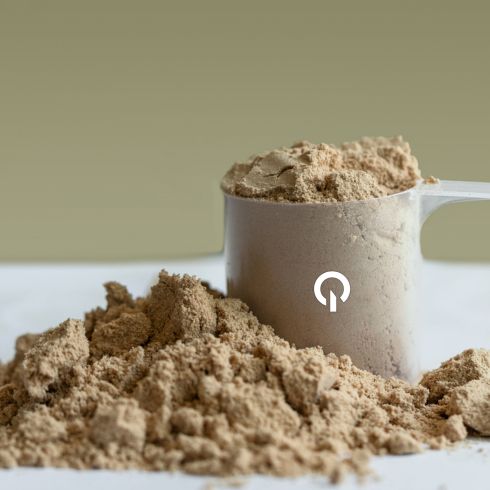Native whey and its benefits
TABLE OF CONTENTS
Native whey manufacturing process
Native whey is obtained from milk through a gentle filtration process, such as microfiltration or ultrafiltration, which removes impurities and fats without denaturing the proteins. Unlike traditional whey, which is a byproduct of milk coagulation during cheese production, native whey is extracted directly from fresh milk. This process preserves intact protein fractions, such as immunoglobulins and lactoferrins, which are beneficial for health.
Composition and nutritional benefits.
Native whey is distinguished by its high protein content and low fat and lactose levels. It contains all the essential amino acids needed for muscle growth and repair, as well as bioactive peptides that can have beneficial effects on the immune system and gut health. Additionally, native whey is rich in leucine, a key amino acid for stimulating muscle protein synthesis.
The nutritional benefits of native whey include:
- High protein content: Generally, native whey contains about 90% pure protein, making it a concentrated and efficient source of protein for athletes and active individuals.
- Low lactose content: Thanks to its filtration process, native whey is almost lactose-free, making it suitable for people with lactose intolerance.
- Bioactive peptides: The intact protein fractions present in native whey can support the immune system and provide anti-inflammatory benefits.
Benefits of native whey for athletes.
For athletes, native whey offers several specific benefits related to performance and recovery:
- Rapid absorption: Native whey is quickly digested and absorbed, allowing for rapid delivery of amino acids to the muscles, promoting quick recovery after exercise.
- Increased protein synthesis: The high leucine content in native whey effectively stimulates muscle protein synthesis, aiding in muscle repair and growth.
- Immune support: The bioactive peptides can strengthen the immune system, which is crucial for athletes undergoing intense training and periods of physical stress.
Comparison with other forms of protein.
While native whey offers distinct advantages, there are other forms of protein that can also be beneficial for muscle recovery. Traditional whey proteins, plant-based proteins, and protein blends each offer unique nutritional profiles and specific benefits. For example, plant-based proteins are ideal for individuals following a vegan or vegetarian diet, and protein blends can provide a prolonged release of amino acids.
Native whey is thus a high-quality form of protein extracted directly from milk, offering exceptional purity and protein content. Its benefits for muscle recovery and athletic performance make it a popular choice among athletes. However, it is important to consider other available protein alternatives to meet individual needs and dietary preferences.
WHAT IS THE DIFFERENCE BETWEEN NATIVE WHEY AND OTHER TYPES OF PROTEIN, PARTICULARLY WHEY PROTEIN ISOLATE?
Native whey and whey protein isolate are two types of whey proteins commonly used in sports nutrition. Although they share some similarities, they also have significant differences in terms of composition, manufacturing process, and specific benefits. Here is a detailed overview of these distinctions.
Native Whey: Optimal purity right from the source.
Nutritional Composition
- Proteins: Approximately 80-90% pure protein.
- Lactose: Low content, suitable for those with lactose intolerance.
- Fats: Very low content.
- Bioactive Peptides: Intact presence of bioactive fractions beneficial for health.
Benefits
- High purity and nutritional quality.
- Rapid absorption for effective muscle recovery.
- Immune support through bioactive peptides.
Origin and Manufacturing Process
Whey protein isolate is also derived from milk, but through a more intensive filtration process, such as ultrafiltration and cross-flow microfiltration. This process aims to almost entirely remove fats and lactose, thereby concentrating the protein content.
Nutritional Composition
- Proteins: 90% or more pure protein.
- Lactose: Less than 1%, often practically none, making it an ideal option for those highly sensitive to lactose.
- Fats: Very low content, usually less than 1%.
Benefits
- Very high protein content to maximize protein intake.
- Low fat and lactose content, ideal for low-calorie diets.
- Rapid and efficient absorption.
Comparison with other types of protein.
Whey Protein Concentrate
- Proteins: Approximately 70-80% protein.
- Lactose: Contains more lactose than isolate and native whey.
- Fats: More fat than isolate.
Plant-Based Proteins (e.g., Pea, Rice, Hemp)
- Proteins: Varies by source, generally between 60-80%.
- Lactose: Lactose-free.
- Fats: Varies by source.
- Benefits: Vegan and hypoallergenic options.
- Proteins: Approximately 80% protein.
- Lactose: Contains lactose.
- Fats: Varies.
- Benefits: Slow digestion, prolonged release of amino acids.
Native whey and whey protein isolate are two high-quality forms of whey protein, each offering specific benefits depending on individual needs and goals. Native whey stands out for its optimal purity and preservation of bioactive peptides, while whey protein isolate is known for its very high protein concentration and low lactose and fat content. Depending on your sports nutrition and muscle recovery goals, it is essential to choose the protein source that best fits your needs. QNT products offer a diverse range of proteins, ensuring tailored solutions for every athlete.
WHY CHOOSE ALTERNATIVES TO NATIVE WHEY?
Native whey is often praised for its benefits in muscle recovery, thanks to its high protein content and rapid absorption. However, there are several reasons why one might opt for alternatives. Here’s why choosing alternatives to native whey can be advantageous:
Diversity of protein sources.
Alternatives to native whey, such as standard whey proteins, plant-based proteins, and protein blends, offer a variety of protein sources. This allows for nutritional diversity and the unique benefits of each type of protein. For example, plant-based proteins like pea, rice, and hemp are excellent for those following a vegan or vegetarian diet, while still providing essential amino acids.
Less risk of intolerances and allergies.
Some people may have difficulty digesting native whey due to lactose intolerance or dairy allergies. Alternatives such as plant-based proteins or lactose-free whey proteins are ideal for avoiding these digestive issues, while still ensuring sufficient protein intake for muscle recovery.
Impact environnemental.
Plant-based proteins generally have a lower environmental impact than dairy-derived proteins. Opting for plant-based alternatives can therefore be a more sustainable and environmentally friendly choice, aligned with an eco-responsible lifestyle philosophy.
Quality and performance.
The alternatives offered by QNT make no compromises on quality or performance. Our products are rigorously tested and formulated to ensure maximum purity and effectiveness. Whether you choose our whey proteins, plant-based protein blends, or other specialized supplements, you can be confident that you’re receiving optimal support for muscle recovery.
Choosing alternatives to native whey can offer many benefits, from nutritional diversity and reduced risk of intolerances to a lower environmental impact. QNT products, whether they are high-quality whey proteins or complete plant-based proteins, are designed to help every athlete achieve their recovery and performance goals effectively and sustainably.
COACH'S TIPS

- It is always beneficial to vary your sources of protein. Don’t hesitate to include as much variety as possible.
Related posts
-
 Summer holidays: How to limit the damage?
Posted in: Our tips24/06/2021On holiday, we often tend to let ourselves go. Unless you're a hardcore sportsman, you tend to abandon your trainers...Read more
Summer holidays: How to limit the damage?
Posted in: Our tips24/06/2021On holiday, we often tend to let ourselves go. Unless you're a hardcore sportsman, you tend to abandon your trainers...Read more -
 Which fat burner to choose?
Posted in: Our tips26/05/2021To lose weight and burn fat, there is no secret: you have to do sport and take care of your diet. However, it is...Read more
Which fat burner to choose?
Posted in: Our tips26/05/2021To lose weight and burn fat, there is no secret: you have to do sport and take care of your diet. However, it is...Read more -
 Summer body edition for men: How to prepare your body?
Posted in: Our tips11/05/2021Gentlemen ? The return of the sun and its warm rays are almost here! The degrees are slowly but surely rising, but...Read more
Summer body edition for men: How to prepare your body?
Posted in: Our tips11/05/2021Gentlemen ? The return of the sun and its warm rays are almost here! The degrees are slowly but surely rising, but...Read more -
 9 good reasons to do sport.
Posted in: Our tips22/04/2021Sometimes the urge to exercise is not always there. And although we always tell ourselves that this year will finally...Read more
9 good reasons to do sport.
Posted in: Our tips22/04/2021Sometimes the urge to exercise is not always there. And although we always tell ourselves that this year will finally...Read more -
 Discover how to take care of your faithful companion: your shaker!
Posted in: Our tips07/04/2021In your bag, in your hand, in your sink, it is everywhere! The shaker is an essential element of any good training....Read more
Discover how to take care of your faithful companion: your shaker!
Posted in: Our tips07/04/2021In your bag, in your hand, in your sink, it is everywhere! The shaker is an essential element of any good training....Read more
Blog categories
Popular posts
-
 Looking thinner but at a heavier weight? Is that possible?04/10/2021Posted in: Our tipsAdvertising has shaped our thinking! We have been forced for years to believe that losing weight is the key to having...Read more
Looking thinner but at a heavier weight? Is that possible?04/10/2021Posted in: Our tipsAdvertising has shaped our thinking! We have been forced for years to believe that losing weight is the key to having...Read more -
 Proteins for weight loss !29/12/2023Posted in: Our tipsDive into the fascinating world of proteins and their key role in weight loss. Discover how to choose the best...Read more
Proteins for weight loss !29/12/2023Posted in: Our tipsDive into the fascinating world of proteins and their key role in weight loss. Discover how to choose the best...Read more -
 Which foods boost testosterone levels ?07/05/2021Posted in: Food supplementsTestosterone, often associated with virility, has much more to offer than you might think. It plays a crucial role in...Read more
Which foods boost testosterone levels ?07/05/2021Posted in: Food supplementsTestosterone, often associated with virility, has much more to offer than you might think. It plays a crucial role in...Read more -
 10 BENEFITS OF GLUTAMINE.02/01/2024Posted in: Our tipsDiscover the power of L-glutamine, an underrated superhero in the world of amino acids! Essential for revitalizing...Read more
10 BENEFITS OF GLUTAMINE.02/01/2024Posted in: Our tipsDiscover the power of L-glutamine, an underrated superhero in the world of amino acids! Essential for revitalizing...Read more -
 Is there a link between sex and sport?14/11/2019Posted in: LifestyleMany have already asked questions about sex and sport. Most of the time, people want to be reassured by the many...Read more
Is there a link between sex and sport?14/11/2019Posted in: LifestyleMany have already asked questions about sex and sport. Most of the time, people want to be reassured by the many...Read more

.jpg)

